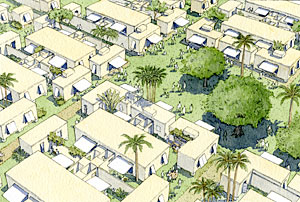
Image courtesy Andr's Duany
Andr's Duany has conceived prefab dwellings whose layouts and size would vary slightly depending upon their locale ' city blocks (pictured), suburbs, or the countryside.
Fireproof, waterproof, and mold-proof, the resin-clad foam panels are strong and flexible enough to withstand both earthquakes and hurricanes, which means that they’re a huge improvement over the masonry and corrugated steel used as building materials in Haiti today, Duany says.
To help get these houses built, Duany has teamed up with InnoVida, a panel manufacturer. Founded in Miami Beach in 2005, the company now has seven factories around the world. Duany is listed as InnoVida’s chief design officer and sits on the board but has no financial ties to the company, according to Duany and company officials.
Duany considered the company’s products for homes he designed in New Orleans after Hurricane Katrina. And earlier this year, he was working with the company on prefab houses he designed for the Little Haiti section of Miami.
His new houses would be assembled in Haiti, in a factory that has yet to be built. The factory will cost $15 million, according to Craig Toll, the company’s chief financial officer, and InnoVida will contribute $5 million of that. The balance will be covered by a recently secured loan, Toll says.
But the company also requires another $5 million to manufacture its first batch of 1,000 homes for Haiti, and it’s now talking to U.S. foundations to help cover some of that cost. After that initial batch, InnoVida will sell the homes, for between $5,000 and $7,500 each, officials say.
Duany traveled to Haiti in early February with Innovida representatives and an anthropologist, to conduct visual surveys of the disaster. He wanted to see the situation firsthand, as historically, homes that relief groups have rushed to put up after natural disasters haven’t been considerate of how people actually live, says Duany.
His proposed Haitian dwellings forego space for furniture, as many residents just sit on the lips of the open sides of their homes, which are usually propped up on blocks. Plus, his homes don’t have traditional windows, which can let in criminals, bugs, and evil spirits, according to popular thinking, but hinged panels with screens that can be securely fastened.
While other architects have suggested holding a competition to come up with an ideal new home model for Haiti, Duany points out that the rainy season is quickly approaching, in May. “It is absolutely urgent,” he says, “that we do something now.”
But InnoVida’s assembly lines need to get up and running first. “I don’t think we can move as quickly as we want, since the country is still a disaster site,” Neli Santamarina, a business development director for the company. “It’s complex.”



Post a comment to this article
Report Abusive Comment